Last edit: 18/10/2025
The Doubt
Why a metal part has to be connected to a PE (Protection Earth) conductor
CONSIDERATIONS:
There are 7 reasons why a piece of metal has to be bonded: let’s see them one by one.
1 – Connection to the PE conductor of Exposed conductive parts (ECP)
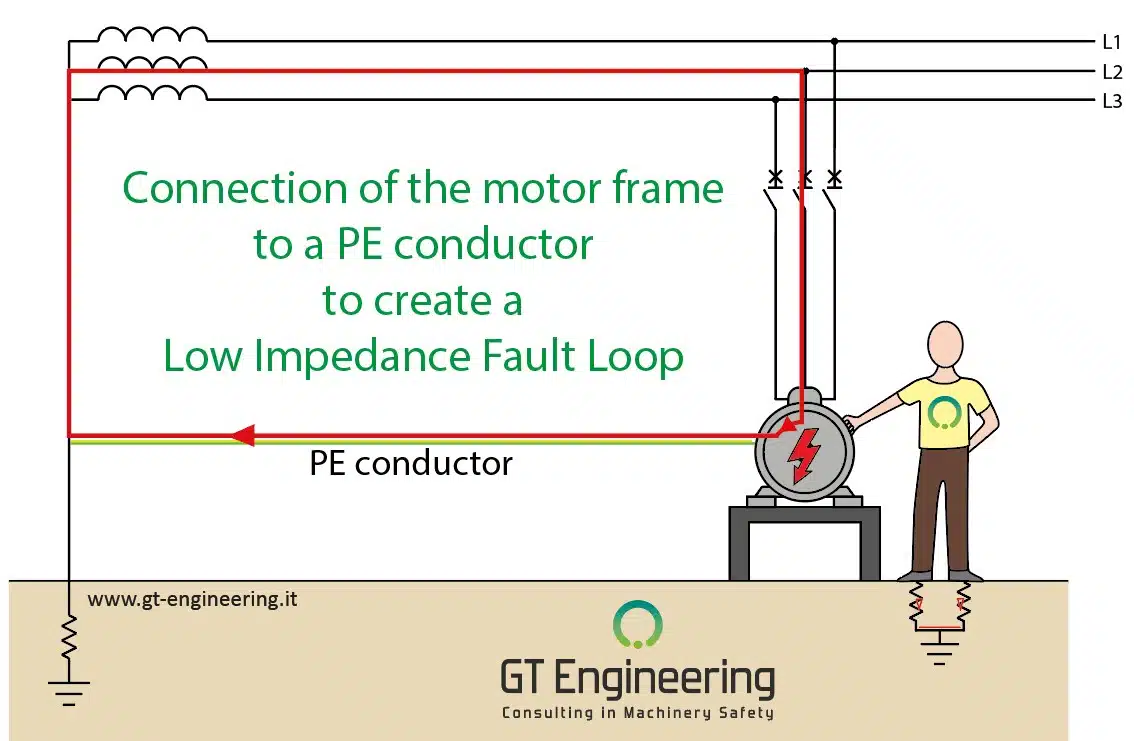
An Exposed Conductive part (ECP) is a metal part, belonging to an electrical system (for example the metal frame of a motor) that can become energised in case of one fault in its electrical system.
For example, a lack of proper insulation of the motor stator windings can cause the motor frame to become energised: in that case the frame will assume a voltage to ground that depends upon the nominal voltage of the electrical distribution. For example a 460 volt ac motor (that means a 480Y/277 Vac electrical distribution), in case of a bolted ground fault, will reach a voltage to ground equal to 277 Vac.
That is a dangerous voltage and,in case a person touches the frame, he is subject to an electrical shock. In order to avoid irreversible consequences, the motor frame must be connected to a PE conductor, meaning, connected to the electrical panel grounding terminal with an Equipment Grounding Conductor EGC or PE Conductor.
Be aware that different part of the world use different terminology to mean the same thing. Hereafter the four main terminologies, when dealing with the creation of a Fault Loop.
- An IEC 60364 member would say “The motor frame must be connected to a Protective Earthing (PE) conductor“.
- A NEC Member would say “The motor frame must be Grounded using an Equipment Grounding Conductor (EGC)”.
- A CE Code Member would say “The motor frame must be Bonded using a Bonding Conductor“.
- A IEC 60204 Member would say “The motor frame must be Bonded using a Protective Conductor“.
The World of Electrical Safety is nice, isn’t it?
2 – Bonding of Extraneous conductive parts (ExCP)
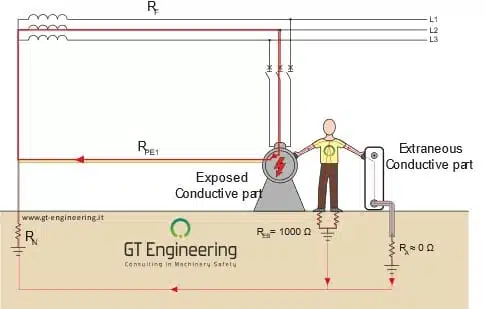
An Extraneous conductive part (ExCP) is a metal part, not belonging to the electrical system (for example a heat exchanger in a plant) that can introduce the earth potential in the area where an operator is working.
[IEC 61140: 2016] 3 Terms and definitions – 3.7 extraneous-conductive-part
Conductive part not forming part of the electrical installation and liable to introduce an electric potential, generally the electric potential of a local earth
If the operator touches both the motor frame and the heat exchanger, while the motor frame is subject to a ground fault, two currents will flow through the person: the hand-feet current and the hand-hand current through the Extraneous Conductive Part (ExCP). The sum is a current greater than that assumed for indirect contacts (hand-feet only).
The person is therefore in a dangerous situation! That is the reason why the heat exchanger must be made equipotential with the motor by, for example connecting, both together by means of a Protective Bonding Conductor (PB). By doing that, the motor case (ECP) and the Heat Exchanger (ExCP) become equipotential and therefore there is not anymore any current flowing hand-to-hand to the Heat exchanger. The “negative” effect due to the presence of an ExCP has been eliminated. Even if the person touches both the motor and the ExCP, he will be subject to the same current as if he would be touching the motor case only!
Please consider the fact that the heat exchanger, if not bonded, is not likely to assume any voltage in case the motor has a ground fault, however it has to be bonded since it is an Extraneous Conductive Part. That is an evidence that the rule “bond all metal parts that are likely to become energised” is a misleading guideline: the Heat exchanger will NEVER assume any dangerous voltage, BUT it must be bonded!
Last remark, that helps to understand what an extraneous-conductive-part is: an Extraneous conductive part introduces a potential NOT a (dangerous) Voltage!
3 – Earthing of the Neutral point of an electrical system
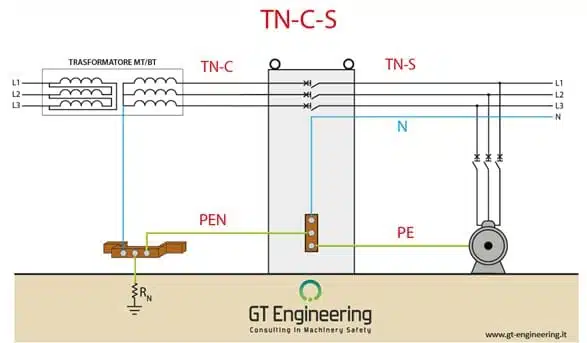
In order to create a TN-S or a TN-C system, the common point on the low voltage side of a MV/LV transformer has to be grounded (USA or Canada) or earthed (rest of the world), meaning connected to the “dirty ground”.
4 – Earthing of the Lightning protection System (LPS)
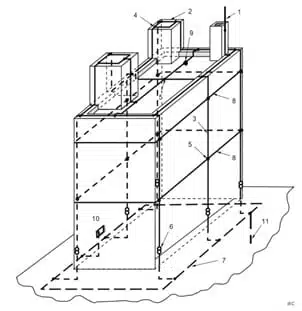
A Lightning protection System (LPS) has to be “Earthed” in order to disperse the lightning current safely towards earth. The connection is also called earth-termination system.
The purpose of the external LPS is to protect the structure from a direct lightning strike by providing a preferred attachment point, for conducting and dispersing the lightning current.
The external LPS is intended to intercept direct lightning flashes to the structure, including flashes to the side of the structure, and conduct the lightning current from the point of strike to ground. The external LPS is also intended to disperse this current into the earth without causing thermal or mechanical damage, or dangerous sparking which may trigger fire or explosions.
5 – Bonding in order to reduce the Electromagnetic Interferences
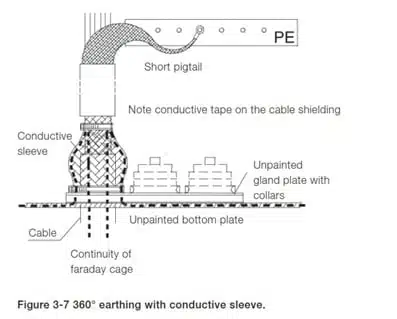
Bonding can reduce the Electromagnetic Interferences. One of the unplanned benefits of using a metallic conduit as grounding conductor and as wiring raceway is that any electrical noise emanating from the electrical system conductors will get suppressed. The conduit acts like a screen for electromagnetic flux, which get trapped within the screen and does not radiate outside the enclosure. This is of particular relevance in modern electrical systems where use of power semiconductors creates harmonic current flow through the system as well as line voltage notching, which can act as noise source by radiation from electrical power conductors. When the conductors supplying power to such equipment are enclosed within the metallic raceway, such electromagnetic interference (EMI) automatically gets suppressed.
6 – Bonding in order to reduce the risk of electrostatic discharges

Static electricity is well known risk, especially in classified locations (ATEX). Under certain circumstances, a discharge of static electricity can create the spark that starts a fire or triggers an explosion. The explosion that destroyed the Hindenburg, for instance, is believed to have been caused by static electricity. As a result, many industrial processes/operations need to be carefully scrutinized to minimize the possibility that static electricity will set off a devastating incident.
In order to reduce the risk of accumulation of electrostatic charges all conductive and dissipative items should be bonded together and earthed. That guarantees that a relatively low impedance path to earth exists so that electrostatic charges are automatically discharged to earth. Please notice that the maximum resistance that guarantees safety is about 1 MΩ!
7 – Bonding of control circuits fed by transformers or DC power supplies

The “common” pole of the control transformer in a machinery has to be bonded to the control panel grounding bar in order to prevent malfunctioning of the control circuits in case of a fault, as indicated in the drawing. In the example, one of the two poles of the transformer and all metal parts that contain control circuits, even in case of Extra-low voltage sources, are bonded. By doing so, when the first ground fault happens in the field, like shown in the figure, the overcurrent protection “I >” opens, contactor “K” is de-energised, the corresponding motor is stopped and the machinery goes into a safe state.
Conclusions
In order to decide whether a metal part has to be Bonded or Earthed (Grounded in USA and Canada language), you need to consider all those seven reasons. If none of the reasons is applicable, don’t bond it! The rule that “all metal parts that can become energised have to be bonded” is misleading, like it is misleading the more general rule “if it is a metal part and it does not move, than ground it!”: Follow the seven rules and your installation will be safe!